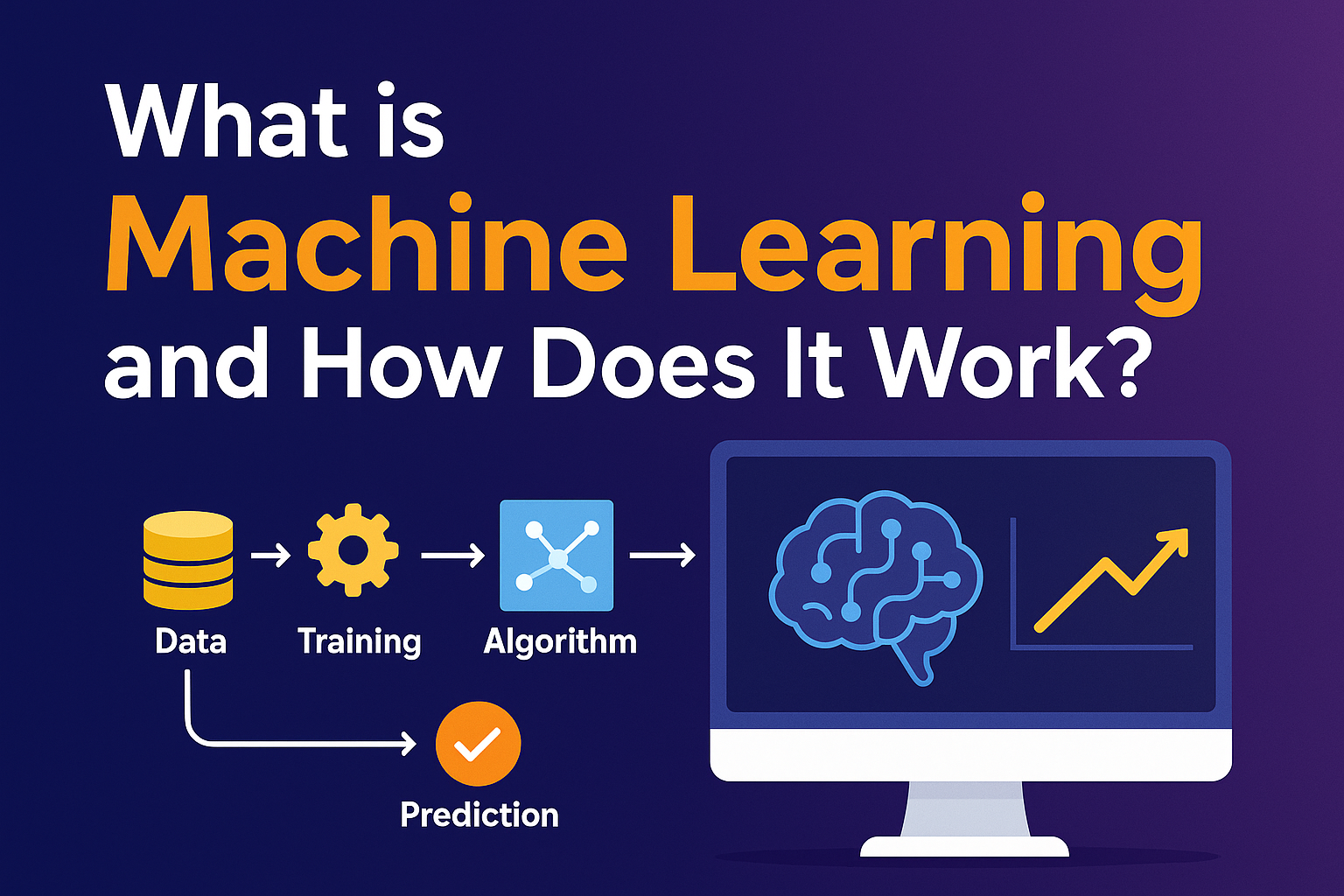
What is Machine Learning and How Does It Work?
Machine Learning (ML) is one of the most revolutionary technologies shaping our digital world today. From product recommendations and fraud detection to autonomous vehicles and AI chatbots, machine learning is everywhere. But what exactly is machine learning, and how does it work?
In this in-depth guide, we’ll explore the fundamentals of machine learning, its core types, how it works step by step, its real-world applications, and the future it holds. Whether you’re a beginner, digital marketer, or tech enthusiast, this post is for you.
Understanding the Basics: What is Machine Learning?
Machine Learning is a subset of Artificial Intelligence (AI) that enables systems to learn from data and improve over time without being explicitly programmed.
Instead of hardcoding every instruction, ML models use algorithms to identify patterns and make decisions based on historical data. The more data the model receives, the better it performs.
Definition: Machine learning is the process by which computers use statistical techniques to “learn” from data, recognize patterns, and make predictions or decisions.
Types of Machine Learning
There are three main types of machine learning, each with unique techniques and use cases:
1. Supervised Learning
The model learns from labeled data—i.e., both inputs and desired outputs are known.
Examples:
- Email spam detection
- Credit scoring
- Predicting house prices
2. Unsupervised Learning
The model identifies hidden patterns or groupings in data without labeled outputs.
Examples:
- Customer segmentation
- Market basket analysis
- Anomaly detection
3. Reinforcement Learning
An agent learns by interacting with an environment and receiving feedback through rewards or penalties.
Examples:
- Game AI (like AlphaGo)
- Robotics
- Real-time bidding in digital advertising
How Machine Learning Works: Step-by-Step
Here’s a simplified breakdown of how machine learning models are built and deployed:
Step 1: Define the Problem
What are you trying to predict or classify? Start with a clear objective like “predict customer churn” or “classify emails as spam or not.”
Step 2: Gather Data
Data is the fuel of machine learning. It could be structured (spreadsheets, databases) or unstructured (images, text, video).
Learn more in our blog: How AI Tools Are Trained: From Data to Deployment
Step 3: Clean and Prepare Data
Cleaning involves removing duplicates, handling missing values, and formatting the data correctly. This step is crucial for model accuracy.
Step 4: Choose the Right Algorithm
Algorithms are the mathematical engines behind machine learning. Popular ones include:
- Decision Trees
- Support Vector Machines (SVM)
- K-Nearest Neighbors (KNN)
- Neural Networks
Step 5: Train the Model
Feeding the cleaned dataset into the algorithm to help it “learn” the patterns. This usually involves splitting data into training and validation sets.
Step 6: Evaluate the Model
Measure the model’s performance using metrics such as:
- Accuracy
- Precision & Recall
- F1 Score
- ROC-AUC Curve
Step 7: Deploy the Model
Once validated, the model is deployed into production where it starts making predictions on real data.
Step 8: Monitor & Improve
Models can drift over time. It’s important to continuously monitor performance and retrain with fresh data as needed.
Real-World Applications of Machine Learning
Machine Learning powers a wide range of industries:
🛍️ E-commerce
- Personalized product recommendations
- Customer segmentation
- Predictive pricing
💳 Finance
- Fraud detection
- Credit scoring
- Algorithmic trading
🏥 Healthcare
- Disease diagnosis from X-rays and MRIs
- Predicting patient outcomes
- Drug discovery
🛡️ Cybersecurity
- Intrusion detection
- Phishing detection
- Real-time threat monitoring
Upcoming Post: “AI for Cybersecurity Automation” — Learn how AI tools are revolutionizing cyber defense mechanisms in our upcoming blog.
📱 Social Media
- News feed personalization
- Sentiment analysis
- Content moderation
Benefits of Machine Learning
| Benefit | Description |
| Automation | Automates repetitive tasks and decision-making |
| Accuracy | Improves over time with more data |
| Scalability | Easily handles massive volumes of data |
| Personalization | Tailors user experiences in real-time |
| Competitive Advantage | Gives businesses insights and capabilities at scale |
Common Machine Learning Algorithms
| Algorithm | Use Case |
| Linear Regression | Predicting numerical values |
| Logistic Regression | Binary classification (e.g., spam or not) |
| Decision Trees | Hierarchical classification problems |
| Random Forest | Ensemble learning for better accuracy |
| K-Means Clustering | Customer segmentation |
| Naive Bayes | Text classification, spam filtering |
| Neural Networks (DNNs) | Image, speech, and text recognition |
Challenges in Machine Learning
Despite its benefits, machine learning isn’t without hurdles:
- Data Privacy Issues: Especially with sensitive data like health or finance.
- Bias in Data: Models can learn harmful biases present in training data.
- Model Interpretability: Some algorithms (like deep learning) are black boxes.
- Cost & Resources: Requires high computational power and skilled professionals.
Tools & Platforms for Machine Learning
Here are some widely used platforms and libraries:
- TensorFlow: Google’s open-source ML platform
- Scikit-learn: Python-based ML library
- PyTorch: Facebook’s ML framework
- AWS SageMaker: Cloud-based model training
- Google Cloud AI: Scalable AI services
The Future of Machine Learning
In the coming years, machine learning will become more:
- Accessible: No-code and low-code tools will make ML easier for non-coders.
- Explainable: Advances in interpretability will build trust.
- Integrated: ML will be baked into almost all software products.
- Human-Centric: Focus will shift toward ethical and responsible AI.
Conclusion
So, what is machine learning? It’s the backbone of modern AI, allowing computers to learn, adapt, and improve based on experience. From automating everyday tasks to enabling breakthrough innovations, machine learning is reshaping how we live and work.
As the technology evolves, understanding its basics is no longer optional—it’s essential. Whether you’re in marketing, healthcare, finance, or tech, now’s the time to embrace the power of machine learning.



